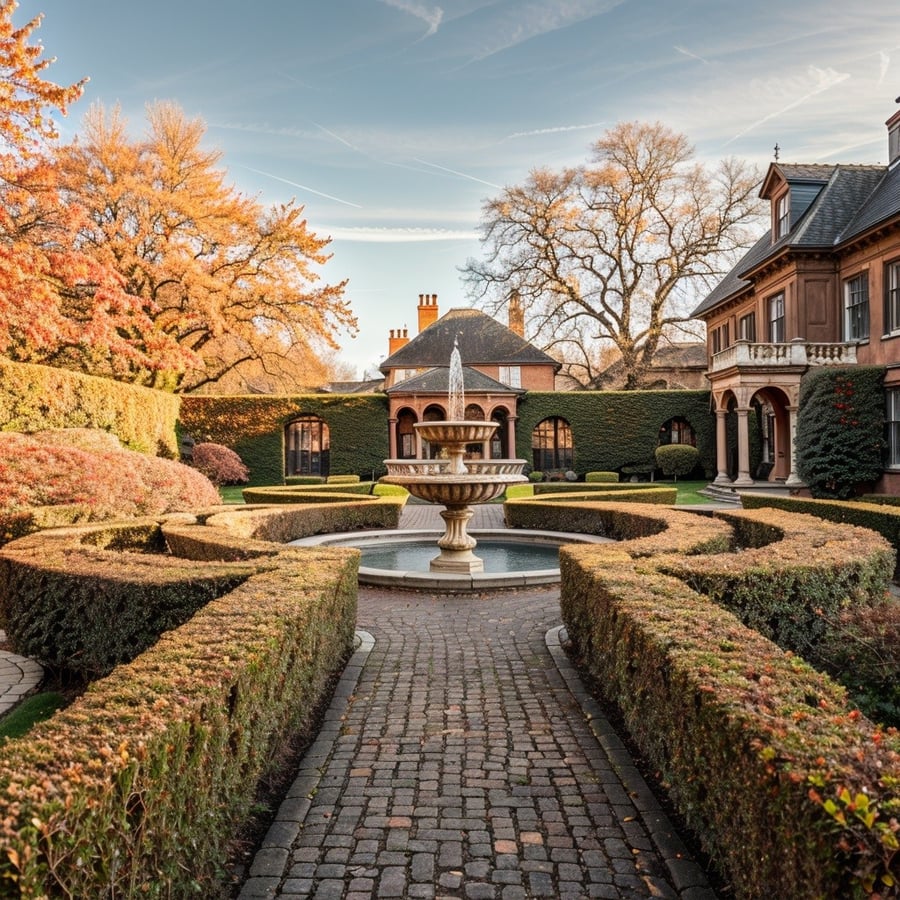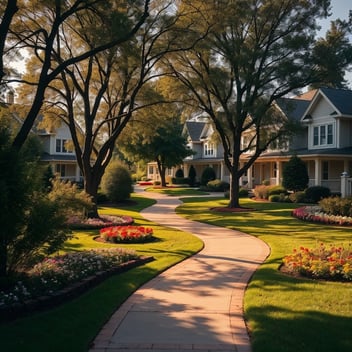Mastering Historical Landscape Maintenance: Expert Tips and Strategies

Introduction: The Art and Science of Historical Landscape Preservation
After spending 25 years transforming outdoor spaces across Long Island, I've developed a deep appreciation for the unique challenges and rewards of maintaining historical landscapes. These living museums tell stories of architectural evolution, cultural shifts, and horticultural innovation. Throughout my career leading high-end landscape projects, including several historic estate renovations in the Hamptons, I've discovered that preserving these spaces requires a delicate balance of historical accuracy and modern sustainability.
Whether you're a property owner of a historic estate or a manager of a heritage site, understanding the intricacies of historical landscape maintenance is crucial for preserving these invaluable spaces for future generations. Let's explore the essential aspects of maintaining historical landscapes while ensuring they remain both beautiful and functional in today's context.
Understanding Historical Landscape Elements
Historical landscapes are complex compositions that reflect the cultural values, architectural styles, and gardening practices of their time. As someone who's overseen numerous luxury landscaping projects in exclusive communities, I've learned that successful preservation starts with understanding these key elements:
Structural Features
- Original Hardscaping: Historic properties often feature distinct hardscape elements like period-appropriate pathways, terraces, and stone walls. These elements require specialized maintenance techniques to preserve their authenticity while ensuring structural integrity. For instance, when restoring a 19th-century cobblestone pathway, we must carefully document the original pattern and materials, then use period-appropriate methods for repairs while incorporating modern drainage solutions beneath the surface.
- Water Features: Historical fountains, reflecting pools, and irrigation systems present unique preservation challenges. Many historic estates feature intricate water systems that need to be carefully maintained while respecting their original design. I once restored a Victorian-era fountain where we had to recreate the original copper piping system but integrated modern filtration technology discreetly to ensure longevity.
- Garden Structures: Period-specific arbors, gazebos, and decorative elements require regular maintenance with historically accurate materials and techniques. These structures often serve as focal points in historical landscapes and demand careful attention to detail during restoration and maintenance.
Plant Materials
- Heritage Plants: Historical landscapes often feature rare or heritage plant varieties that were popular during the property's original period. Maintaining these specimens requires specialized knowledge of historical cultivation practices and modern preservation techniques. We often work with botanical gardens and heritage plant specialists to source appropriate varieties and maintain genetic diversity.
- Traditional Planting Schemes: Understanding and preserving historical planting patterns and design principles is crucial. Many historic gardens follow specific design schools, such as the Victorian gardenesque style or Colonial American formal gardens. Each style has its own rules for plant placement, color schemes, and seasonal displays that must be respected.
- Mature Specimen Trees: These living landmarks often predate the buildings they surround and require expert care to ensure their longevity. Proper maintenance of mature trees involves regular health assessments, careful pruning, and sometimes the use of specialized support systems to preserve these irreplaceable specimens.
Preservation Strategies and Best Practices
Maintaining historical landscapes requires a comprehensive approach that balances preservation with practical considerations. Through my experience creating and maintaining luxurious community green spaces, I've developed several key strategies:
Documentation and Research
- Historical Research: Before beginning any maintenance program, thoroughly research the property's history through architectural records, historical photographs, and period documents. This research forms the foundation for authentic preservation decisions and helps understand the original design intent. I maintain detailed digital archives for each historical property, including period photographs, planting plans, and maintenance records.
- Current Conditions Assessment: Regular documentation of existing conditions helps track changes and inform maintenance decisions. Using modern technology like drone photography and 3D mapping can create detailed records while maintaining historical accuracy. We perform quarterly assessments of all structural and botanical elements to catch potential issues early.
- Maintenance Planning: Develop detailed maintenance plans that respect historical integrity while incorporating modern best practices. These plans should be living documents that evolve with the property while maintaining its historical significance.
Sustainable Preservation Techniques
- Water Management: Implement historically appropriate but efficient irrigation systems. Many historical properties can benefit from modern water management techniques without compromising their authenticity. For example, we've successfully integrated smart irrigation controllers into historic properties by concealing modern equipment within existing structure.
- Soil Health: Maintain soil quality using traditional methods enhanced by modern soil science. Historical landscapes often benefit from organic amendments and biological soil management techniques that align with traditional gardening practices.
- Integrated Pest Management: Use period-appropriate plant protection methods combined with modern ecological approaches. This might include encouraging beneficial insects, using traditional companion planting, and applying modern organic treatments when necessary.
Seasonal Maintenance Considerations
Historical landscapes require carefully planned seasonal maintenance routines that respect traditional gardening calendars while adapting to modern climate challenges:
Spring
- Awakening the Garden: Begin the season with traditional spring cleaning practices, including careful removal of winter protection materials and debris. Historic gardens often feature delicate spring bulb displays that require specialized care during emergence. We maintain detailed timing records for each garden to anticipate and protect early-emerging plants.
- Structural Repairs: Address any winter damage to historical features while weather conditions are optimal. This includes repointing historical stonework, repairing wooden structures, and maintaining drainage systems. Spring is also ideal for documenting and planning major restoration projects for the coming year.
- Plant Division and Propagation: Many historical plants benefit from traditional division and propagation techniques performed in spring. Maintaining historical plant varieties often requires creating backup collections to ensure the survival of rare specimens.
Summer
- Active Growth Management: Monitor and maintain historical planting schemes during peak growing season. This includes traditional pruning techniques, period-appropriate staking methods, and careful water management. We often use historical gardening calendars as guides while adapting to current climate conditions.
- Visitor Impact Management: Balance public access with preservation needs during peak visitation periods. This might involve rotating access to sensitive areas or implementing protective measures that don't detract from the historical experience.
- Documentation: Summer is ideal for updating photo documentation and conducting detailed surveys of the landscape's condition. We use this documentation to plan future preservation efforts and track changes in the landscape over time.
Fall
- Traditional Clean-up: Implement historical fall maintenance practices while preparing for winter protection. This includes collecting seeds from heritage plants, traditional leaf management techniques, and preparing tender plants for winter storage.
- Structural Winterization: Prepare historical water features and structures for winter using traditional methods enhanced by modern materials. This might include draining fountains according to historical practices while using modern anti-freeze solutions in critical areas.
- Planning and Assessment: Review the year's maintenance records and plan for next season's projects. Fall is an excellent time to assess the success of preservation efforts and make necessary adjustments to maintenance plans.
Winter
- Protection Protocols: Implement historical winter protection methods while incorporating modern materials where appropriate. Many historic gardens used traditional techniques like strawing and burlapping that we still employ today, though sometimes with improved materials.
- Infrastructure Maintenance: Focus on maintaining historical structures and features during the dormant season. Winter provides opportunities for detailed inspection and repair of architectural elements without disturbing the growing landscape.
- Research and Planning: Use the off-season for historical research, staff training, and detailed project planning. This is also an excellent time to update documentation and prepare educational materials about the landscape's history.
Challenges and Solutions in Historical Landscape Maintenance
Common Challenges
- Material Authenticity: Finding historically accurate replacement materials can be difficult. We maintain relationships with specialized suppliers and craftsmen who can provide or recreate period-appropriate materials. Sometimes, this involves commissioning custom reproductions of historical elements using traditional techniques.
- Climate Adaptation: Historical landscapes must adapt to changing climate conditions while maintaining authenticity. This often requires careful selection of resilient plant varieties that match historical specimens in appearance and growing habits. We've successfully introduced climate-adapted varieties that maintain the historical aesthetic while providing better resistance to current environmental stresses.
- Modern Usage Requirements: Balancing historical integrity with contemporary needs presents ongoing challenges. Historical landscapes must often accommodate modern safety requirements, accessibility standards, and usage patterns while preserving their period character. We've developed creative solutions like concealed lighting systems and subtle pathway modifications that meet current standards without compromising historical authenticity.
Innovative Solutions
- Technology Integration: Careful incorporation of modern maintenance technology can improve preservation efforts. We use specialized monitoring systems, documentation tools, and maintenance equipment that can be discretely integrated into historical landscapes. These technologies help us maintain historical authenticity while improving efficiency and reducing resource consumption.
- Education and Training: Developing specialized skills in historical landscape maintenance is crucial. We implement comprehensive training programs for maintenance staff, focusing on traditional techniques, historical knowledge, and modern preservation methods. Regular workshops and hands-on training sessions ensure that traditional skills are preserved and passed on.
- Community Engagement: Involving the community in preservation efforts can provide valuable support and resources. Creating volunteer programs, educational initiatives, and partnership opportunities helps build a sustainable foundation for long-term preservation efforts. We've found that engaged communities become powerful advocates for historical landscape preservation.
Conclusion: Preserving Our Landscape Heritage
Maintaining historical landscapes is a complex but rewarding endeavor that requires dedication, expertise, and a deep appreciation for our horticultural heritage. Through careful planning, appropriate techniques, and a balance of traditional and modern approaches, we can preserve these invaluable spaces for future generations while ensuring they remain vibrant and functional in the present.
As we continue to face new challenges in landscape preservation, the principles of careful documentation, sustainable practices, and respectful innovation will guide us in maintaining these living historical documents. The success of historical landscape maintenance lies not just in preserving the past, but in ensuring these spaces remain relevant and appreciated in our modern context.



